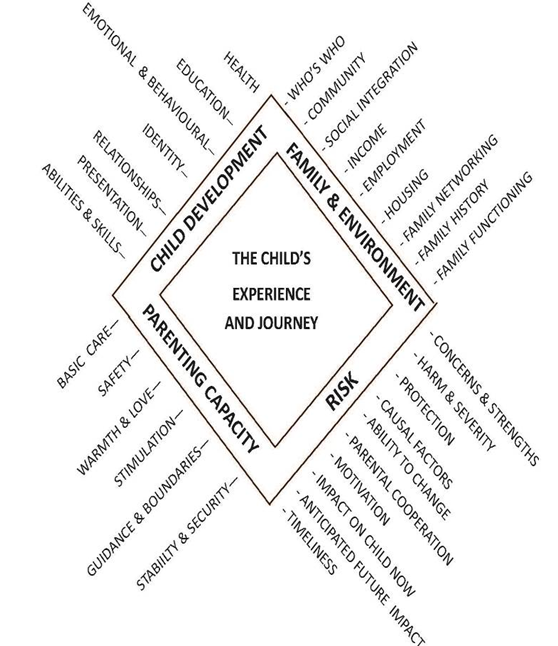This is a post by Sarah Phillimore.
Teasing out the various issues arising under section 17 and section 20 of the Children Act when it comes to ‘providing accommodation’ and the consequences that flow from that, appears to be yet another example of complicated and confusing statutory provisions which put enormous obstacles in the way of parents being able to understand the process. We must either simplify our laws or increase provision of legal aid.
What happens to children under 16 who need help from the State with somewhere to live?
Mrs Justice Black SA v KCC [2010] EWHC 848 (Admin)
“There are various provisions of the Children Act 1989 apart from s 17(6) which deal with the provision of accommodation by a local authority. Although this is not the first time I have had to consider this aspect of the Act, I continue to have difficulty in understanding how the various provisions fit together, how it was envisaged that the scheme would work in practice and how it was thought that it would enable local authorities and others to ascertain, relatively simply, whether a child is looked after or not…”
The distinction between ‘in need’ and ‘looked after’
A child can be a ‘child in need’ and get help and services under section 17 of the Children Act 1989. Or a child can be a ‘looked after’ child and get help and services under section 22 of the Act.
The distinction between these two is significant. A ‘looked after’ child gets more help, including a duty on the LA to consider offering support even when she is older than 18. A ‘looked after’ child will also experience more intervention from the LA, for example the statute provides that frequent reviews are required.
The Children (Leaving Care) Act 2000 creates new categories of young people entitled to support.
- Eligible child – aged 16 or 17 and are currently looked after, either on a care order or accommodated, who has been looked after for a period or periods of 13 weeks since their 14th birthday (this total should include at least one spell of over 4 weeks, but does not include respite). This category defines those who will go on to become Relevant and Former Relevant young people when they cease to be looked after.
- Relevant child – Aged 16 or 17 (not yet 18) and have left care, having previously been in the category of Eligible child.
There is a duty to financially support them up to the age of 18. The allowances paid to them should not fall below the level of Income Support or Income Based Job Seekers Allowance.
There is a further category of ‘Former Relevant child’ , being those aged 18 to 25 and who have
left care having previously been Eligible or Relevant, or both. The LA is under a duty to consider the need to financially support them.
A ‘looked after’ child is defined at section 22 of the Children Act 1989 as a child who is under a care order OR IF the accommodation provided is by the LA ‘in the exercise of its functions’
‘Functions’ exclude anything done under section 17, 23B and 24B of the Children Act 1989.
Accommodation is only ‘accommodation’ if it is provided for a continuous period of more than 24 hours.
So what does this mean?
Section 17 imposes a general duty on the LA to safeguard and promote welfare of children in their area. This may include providing accommodation.
Section 23B relates to 16-17 year olds and section 24B relates to those who are at least 16.
Therefore if your accommodation is provided under section 17 you are NOT a ‘looked after’ child. We must then look to sections 20 and 23 of the Children Act 1989 to understand what are the relevant ‘functions’ which decide whether or not a child is ‘looked after’.
Section 20(4) is ‘permissive’ . It does not impose a duty on a local authority to accommodate a child but says that they can do so if they think it would promote the child’s welfare and those with PR consent.
Section 20(1) however is mandatory – so a local authority MUST provide accommodation to a child if there is no one who has parental responsibility for him, or no one who can exercise it.
Section 23 is also mandatory and tells the LA that when they are looking after a child they must provided accommodation and other services. Section 23(2) sets out that accommodation can be provided by placing the child with family or any other suitable person. These people will be considered foster carers (so must be assessed and found suitable to meet regulations around standard of foster care) UNLESS that person is the child’s parent or has PR for the child or a Child Arrangements Order.
Further, section 23(6) sets out the LA ‘looking after a child shall make arrangements to enable him to live with’ a parent or person with PR, or a relative, friend or other person connected with him. The LA must also try to find accommodation near to his home and with other siblings (section 23 (7)).
The drafting of this section, as Mrs Justice Black recognises, is confusing and seems to set up different routes into ‘providing accommodation’.
It’s not the label that matters, its the facts and the legal consequences.
R (on the application of M) v London Borough of Hammersmith and Fulham [2008] UKHL 13 made it clear that if the LA claim to be acting under section 17, a child will still be a looked after child if the circumstances are such that the LA should have gone down the section 20 route.
Difficulty has arisen when a child goes to live with a relative and the LA claim that this is a ‘private’ arrangement and therefore not one that should be described as the LA ‘providing’ accommodation. The court is willing to accept that there may be some cases where a LA could ‘side step’ their duty to accommodate by helping to set up a private fostering arrangement.
Private fostering arrangements are dealt with in section 66 of the CA and cover children who are under 16 and cared for in their own home by someone other than a parent, a person with parental responsibility or a relative. A ‘relative’ is defined under section 105 of the Children Act 1989 as a grandparent, brother, sister, uncle or aunt (whether by blood or marriage) or step-parent.
Has the LA taken a ‘major role’ in making arrangements for the child to be accommodated?
It is a question of fact in every particular case. Where a LA takes a ‘major role’ in making arrangements for a child to be fostered, it is more likely to be considered to be exercising its duties under sections 20 and 23, no matter what it claims is the label to be attached to its actions.
Helpful issues to analyse are likely to be:
- is the LA attempting to regulate the terms of the placement? for e.g. having a view about the child’s school or who has contact with the child?
- What is the LA saying about providing financial help for the child? A true private arrangement will be between the parents and the proposed carers who must understand that the parents will be providing financial support.
Does it then matter if the LA argues section 23(2) or 23(6)?
The court said ‘no’ in SA v KCC [2010] and set out a simple approach to the statute. If the child falls within section 20(1) – there is no one with PR or no one who can exercise it – then the LA is providing accommodation for the child regardless of whether or not it finds a home with a friend or relative and regardless of whether or not the LA chooses to accommodate a child under section 23(2) or 23(6).
The LA in that case had tried to argue that whenever a child goes to live with a relative under section 23(6) then such children are not ‘provided accommodation’ unless there is care order in place. The court rejected this ‘rigid position’ as being potentially disadvantageous to the child and ignores the ‘enormous variation that there is in the circumstances of children, and their parents and carers’.


